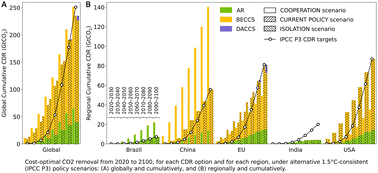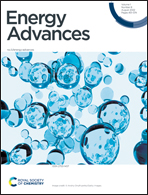CO2 removal and 1.5 °C: what, when, where, and how?
Abstract
The international community aims to limit global warming to 1.5 °C, but little progress has been made towards a global, cost-efficient, and fair climate mitigation plan to deploy carbon dioxide removal (CDR) at the Paris Agreement's scale. Here, we investigate how different CDR options—afforestation/reforestation (AR), bioenergy with carbon capture and storage (BECCS), and direct air carbon capture and storage (DACCS)—might be deployed to meet the Paris Agreement's CDR objectives. We find that international cooperation in climate mitigation policy is key for deploying the most cost-efficient CDR pathway—comprised of BECCS, mainly (74%), and AR (26%)—, allowing to take the most advantage of regional bio-geophysical resources and socio-economic factors, and time variations, and therefore minimising costs. Importantly, with international cooperation, the spatio-temporal evolution of the CDR pathway differs greatly from the regional allocation of the Paris Agreement's CDR objectives—based on responsibility for climate change, here used as a proxy for their socio-economically fair distribution. With limited, or no international cooperation, we find that the likelihood of delivering these CDR objectives decreases, as deploying CDR pathways becomes significantly more challenging and costly. Key domestic bio-geophysical resources include geological CO2 sinks, of which the absence or the current lack of identification undermines the feasibility of the Paris Agreement's CDR objectives, and land and biomass supply, of which the limited availability makes them more costly—particularly when leading to the deployment of DACCS. Moreover, we show that developing international/inter-regional cooperation policy instruments—such as an international market for negative emissions trading—can deliver, simultaneously, cost-efficient and equitable CDR at the Paris Agreement's scale, by incentivising participating nations to meet their share of the Paris Agreement's CDR objectives, whilst making up for the uneven distribution of CDR potentials across the world. Crucially, we conclude that international cooperation—cooperation policy instruments, but also robust institutions to monitor, verify and accredit their efficiency and equity—is imperative, as soon as possible, to preserve the feasibility and sustainability of future CDR pathways, and ensure that future generations do not bear the burden, increasingly costlier, of climate mitigation inaction.

- This article is part of the themed collections: Carbon capture, storage or utilisation – Topic Highlight and Energy Advances 2022 Hot Papers


 Please wait while we load your content...
Please wait while we load your content...